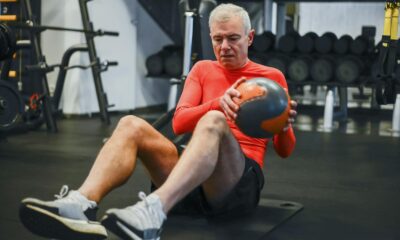Health
Improving Balance Problems and Stability in Elderly Through Targeted Exercises
Improve balance and stability in the elderly with targeted exercises. Enhance mobility, reduce falls/injuries, and improve posture. Find out how!
Are you concerned about the declining balance and stability that often comes with age? Well, worry no more! In this article, we will be discussing the power of targeted exercises in improving balance and stability for the elderly. As we age, it becomes increasingly important to maintain strength and flexibility in order to prevent falls and maintain an active lifestyle. By engaging in specific exercises that target the core, legs, and overall balance, seniors can greatly enhance their stability and decrease the risk of injury. So let’s dive in and discover how incorporating targeted exercises into your daily routine can make a world of difference in your balance and stability as you age.
Benefits of Improving Balance and Stability in Elderly
Enhancing overall mobility and independence
improving balance and stability in the elderly can have numerous benefits, one of the most significant being the enhancement of overall mobility and independence. As we age, our balance naturally declines, leading to a higher risk of falls and injuries. By incorporating specific exercises targeted at improving balance and stability, elderly individuals can regain confidence in their ability to move and perform daily activities with ease.
Reducing the risk of falls and injuries
Falls are a common concern among the elderly, often resulting in serious injuries that can have long-lasting effects on their health and well-being. By focusing on balance and stability exercises, the risk of falls can be significantly reduced. By strengthening the muscles and improving coordination, elderly individuals can maintain their balance and react effectively in situations that may otherwise lead to a fall. This can greatly improve their quality of life and reduce the need for medical intervention and hospitalization.
Improving posture and body alignment
Another important benefit of improving balance and stability in the elderly is the improvement of posture and body alignment. As we age, it is common for posture to deteriorate, leading to chronic pain and discomfort. By engaging in exercises specifically designed to improve balance and stability, elderly individuals can strengthen the core muscles and improve overall posture. This can alleviate pain, prevent muscle imbalances, and promote a more aligned and upright posture.
Factors Affecting Balance and Stability in Elderly
Age-related decline in proprioception
Proprioception, the ability to sense the position and movement of the body, naturally declines with age. This can greatly affect balance and stability in the elderly. As proprioception decreases, it becomes more challenging for the body to maintain stability and react appropriately to changes in the environment. However, by engaging in targeted exercises that focus on proprioception, elderly individuals can improve their body awareness and regain control of their balance.
Muscle weakness and loss of coordination can cause balance problems
Muscle weakness and loss of coordination are common factors that affect balance and stability in the elderly. As we age, muscle mass naturally decreases, resulting in weakened muscles throughout the body. This loss of muscle strength can greatly impact the ability to maintain balance and stability. Additionally, a decline in coordination further contributes to the difficulty of performing daily activities safely. By incorporating exercises that target muscle strength and coordination, elderly individuals can enhance their balance and stability, leading to improved overall functioning.
Medical conditions affecting balance
Various medical conditions can significantly impact balance and stability in the elderly. Conditions such as Parkinson’s disease, stroke, and inner ear disorders can affect the body’s ability to maintain equilibrium. These conditions can lead to impaired balance, gait disturbances, and an increased risk of falls. However, by engaging in targeted exercises and working closely with healthcare professionals, individuals with these medical conditions can work towards improving their balance and stability, thereby enhancing their overall quality of life.

Evaluation of Balance and Stability
Assessment of gait and balance
Evaluating gait and balance is an essential step in determining the current state of balance and stability in the elderly. Healthcare professionals can assess how an individual walks, how they distribute their weight, and whether any abnormalities or compensations are present. This evaluation helps identify areas of concern and guides the development of a personalized exercise program to improve balance and stability.
Functional reach test
The functional reach test is a simple yet effective method to evaluate balance and stability. It involves reaching as far forward as possible while maintaining stability in a standing position. By measuring the distance an individual can reach, healthcare professionals can assess the individual’s ability to maintain balance and stability in various positions.
Timed Up and Go test
The Timed Up and Go (TUG) test assesses an individual’s mobility, balance, and overall functional capacity. It involves timing how long it takes for an individual to stand up from a seated position, walk a short distance, turn around, return to the chair, and sit down again. This test provides valuable information about an individual’s ability to perform daily activities that require balance and stability.
Targeted Exercises to Improve Balance Problems and Stability
Tai Chi
Tai Chi is an ancient Chinese martial art that has gained popularity worldwide for its numerous health benefits, including improving balance and stability. The slow, controlled movements in Tai Chi help strengthen muscles, improve coordination, and enhance body awareness. This low-impact exercise is especially beneficial for the elderly, as it can be adapted to various fitness levels and medical conditions.
Yoga
Yoga is a holistic practice that combines physical postures, breathing exercises, and meditation. It has been shown to have significant benefits for balance and stability in elderly individuals. The practice of yoga helps improve strength, flexibility, and body awareness, all of which are essential for maintaining balance and stability. The gentle nature of yoga makes it suitable for individuals of all fitness levels and can be modified to accommodate any limitations.
Pilates
Pilates is a form of exercise that focuses on core strength, flexibility, body alignment and balance problems. It utilizes controlled movements and emphasizes proper breathing techniques. By targeting the deep stabilizing muscles of the core, Pilates can help improve balance and stability in the elderly. The exercises can be modified to suit individual needs and are effective in promoting overall body strength and control.

1. Tai Chi
Benefits of Tai Chi for balance and stability
Tai Chi has been proven to have numerous benefits for balance and stability in the elderly. By practicing the slow, deliberate movements of Tai Chi, individuals can improve their coordination, body awareness, and postural control. The weight-shifting movements in Tai Chi also help strengthen the leg muscles, which are essential for maintaining balance and stability. Regular practice of Tai Chi can lead to increased stability, reduced risk of falls, and improved overall well-being.
Specific Tai Chi exercises for the elderly
Some specific Tai Chi exercises that are especially beneficial for the elderly include:
- Weight Shifting: This exercise involves shifting the weight from one leg to the other while maintaining stability. It helps strengthen the leg muscles and improves balance.
- Single Leg Stance: This exercise focuses on standing on one leg while maintaining balance and stability. It helps improve leg strength and proprioception.
- Heel-to-Toe Walk: This exercise is similar to a tightrope walk and helps improve balance and coordination. It can be performed by placing one foot in front of the other in a heel-to-toe fashion.
2. Yoga
Enhancing balance and stability through yoga
Yoga is known for its ability to enhance balance and stability in individuals of all ages, including the elderly. The various postures and movements in yoga help improve strength, flexibility, and body awareness, which are essential for maintaining balance and stability. In addition, the focus on proper breathing techniques and relaxation in yoga can help reduce anxiety, enhance concentration, and promote overall well-being.
Recommended yoga poses for the elderly
Some recommended yoga poses for improving balance and stability in the elderly include:
- Tree Pose: This pose involves standing on one leg with the opposite foot placed on the inner thigh or ankle. It helps improve balance, concentration, and strengthens the leg muscles.
- Warrior II: This pose involves standing with the legs wide apart, bending one knee, and extending the arms out to the sides. It helps improve leg strength, stability, and promotes proper body alignment.
- Chair Pose: This pose involves squatting as if sitting on an imaginary chair, with the weight shifted onto the heels. It helps strengthen the leg muscles, improve balance, and promote core stability.
3. Pilates
How Pilates can improve balance and stability
Pilates is renowned for its ability to improve core strength and stability, which are essential for balance and stability in the elderly. The controlled movements in Pilates target the deep stabilizing muscles of the core, including the abdominals, back, and pelvis. By strengthening these muscles, individuals can improve their balance, posture, and overall body control. Pilates also emphasizes proper breathing techniques, which can contribute to a sense of calm and improved concentration.
Key Pilates exercises for the elderly
Some key Pilates exercises that can improve balance and stability in the elderly include:
- Pelvic Curl: This exercise involves lying on the back with the knees bent and lifting the hips off the ground while maintaining stability and control. It helps strengthen the core muscles and improve pelvic stability.
- Single Leg Stretch: This exercise involves lying on the back, bending one knee towards the chest, and extending the other leg in the air. It helps improve core strength, stability, and leg coordination.
- Side Plank: This exercise involves balancing on one hand and the side of the foot while extending the opposite arm towards the ceiling. It helps strengthen the core, shoulder, and hip muscles, improving overall stability and balance.
Incorporating Balance and Stability Training into Daily Routine
Simple exercises to do at home
Incorporating balance and stability training into the daily routine can be done with simple exercises that can be performed at home. Some examples include:
- Heel-to-Toe Walk: Walking in a straight line while placing one foot directly in front of the other, touching heel to toe. This exercise improves balance, coordination, and ankle strength.
- Standing on One Leg: Standing on one leg for a period of time, gradually increasing the duration. This exercise strengthens the leg muscles, improves balance, and stability.
- Hip Abduction: Standing near a support, lifting one leg out to the side while maintaining balance. This exercise targets the hip muscles and improves leg stability and coordination.
Making balance challenges part of daily activities
In addition to specific exercises, incorporating balance challenges into daily activities can further enhance balance and stability in the elderly. Some examples include:
- Standing on One Leg While Brushing Teeth: While brushing your teeth, stand on one leg for the duration of the brushing. This adds a balance challenge and helps improve stability.
- Balancing on One Leg While Cooking: While cooking, try balancing on one leg for short periods, such as when stirring a pot or chopping vegetables. This adds a balance challenge and helps improve coordination.
- Walking on Uneven Surfaces: Walking on uneven surfaces, such as grass or gravel, can challenge balance and stability. Taking short walks on different surfaces can help improve overall stability and body control.
Using assistive devices to enhance stability
In some cases, incorporating assistive devices can be beneficial in enhancing stability in the elderly. Devices such as walking canes or walking sticks can provide additional support and help maintain balance. It is important to consult with a healthcare professional to determine the appropriate assistive device and learn how to use it correctly for maximum benefit.
Safety Considerations for Elderly Individuals
Consulting with a healthcare professional
Before beginning any balance and stability training program, it is crucial for elderly individuals to consult with a healthcare professional. They can assess an individual’s overall health, medical conditions, and provide guidance on appropriate exercises. It is important to take into account any limitations or contraindications in order to ensure safe and effective training.
Using proper equipment and assistance
When engaging in balance and stability exercises, it is important to use proper equipment and seek assistance if needed. This may include using a sturdy chair or wall for support during exercises, wearing appropriate footwear that provides stability and traction, and using any recommended assistive devices. Safety should always be a priority, and individuals should not hesitate to seek assistance if they feel unsure or unstable during any exercises.
Progressing exercises gradually
It is essential to progress balance and stability exercises gradually to avoid overexertion and injury. Starting with basic exercises and gradually increasing the intensity or duration can help the body adapt and strengthen progressively. It is important to listen to the body and make adjustments as necessary. If any exercises cause pain, discomfort, or dizziness, it is important to consult with a healthcare professional and modify the exercise accordingly.
Conclusion
Improving balance and stability in the elderly is crucial for maintaining mobility, independence, and overall well-being. By understanding the factors that affect balance, engaging in targeted exercises such as Tai Chi, yoga, and Pilates, and incorporating balance challenges into daily routines, elderly individuals can greatly enhance their stability and reduce the risk of falls and injuries. It is important to prioritize safety, consult with healthcare professionals, and gradually progress exercises to ensure effective and enjoyable training. With a commitment to improving balance and stability, elderly individuals can enjoy a more confident and active lifestyle.
















